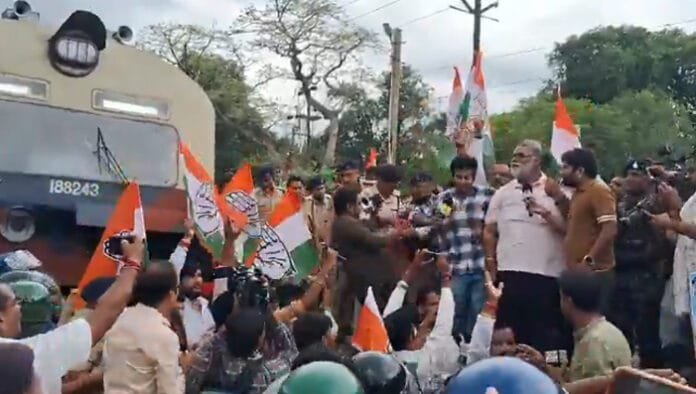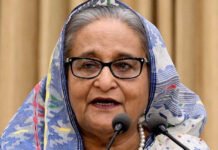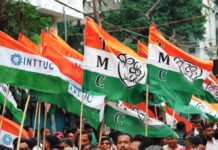The nationwide Bharat Bandh, orchestrated by 10 major trade unions and farmers’ organizations, unfolded today with varied impact across India. From fiery protests in Kolkata to empty roads in Kerala and normalcy in Delhi, the day reflected the country’s complex political and economic dynamics.
Mass Protests Erupt at Jantar Mantar in Delhi
In the heart of the capital, Jantar Mantar witnessed intense protests led by members of the All India Central Council of Trade Unions (AICCTU). Protesters carried placards, raised slogans, and denounced what they termed as “anti-worker and pro-corporate policies” of the central government. The demonstrators demanded the withdrawal of the new labour codes, restoration of the Old Pension Scheme, and implementation of a minimum wage of ₹26,000.
Despite these fiery displays, the Bharat Bandh failed to cripple Delhi, with banks, transport services, and government offices functioning normally.
West Bengal: Clashes, Arson, and Detentions Mark the Day
West Bengal emerged as a focal point of high-voltage drama. In Haldia, CPIM supporters staged a blockade on railway tracks near Bandar railway station, leading to multiple detentions by the police.
In Midnapore, workers tried to halt vehicular movement from the central bus stand, prompting security forces to intervene and detain several union members.
Tensions escalated in Kolkata, where protesters set vehicles ablaze, triggering police action. A bus driver near Jadavpur revealed they were wearing helmets to guard against potential violence, signaling the intensity of the standoff.
Kerala: Complete Shutdown in CPI(M) Stronghold
The impact of the bandh was most profound in Kerala, where life ground to a halt. Roads in Kochi were deserted. Shops and shopping malls in Kottayam remained shut. In Kozhikode, the bandh was strictly enforced with public transport suspended and commercial establishments closed.
The Joint Platform of Trade Unions found resounding support in the CPI(M)-ruled state, where over 25 crore workers voiced opposition to what they labeled as pro-corporate reforms. The 24-hour strike, beginning at midnight, aimed to resist privatization and rollback the four controversial labour codes.
Haryana: Strikes with Mixed Consequences
In Panipat, employees of the municipal corporation, electricity department, and other state units participated in the protest. A sit-in protest at the roadways depot was held by union leaders. However, despite calls for a “chakka jam,” about 100 out of 124 buses continued normal service.
Elsewhere in Kurukshetra, a partial disruption was observed. While some buses were delayed, others ran with limited passenger loads. At Jhajjar, the strike had minimal impact, with roadways buses running as usual on major routes like Delhi and Chandigarh.
Reports from the grain market indicated plans for larger congregations and protests later in the day.
Tamil Nadu: Business as Usual in Key Cities
Contrary to expectations, the Bharat Bandh had negligible influence in Tamil Nadu, especially in Chennai and Tirupur. At the Koyambedu bus stand, buses were seen operating without disruption. In Tirupur, 540 buses ran normally, indicating no participation in the strike.
The Ukkadam bus stand in Coimbatore, however, witnessed a deserted look, particularly for buses heading to Kerala, which were halted as a precaution.
Ranchi Sees CPMDI Protest, But Jharkhand Largely Unmoved
In Jharkhand, members of the All India Trade Union Congress (AITUC) gathered outside the CMPDI headquarters in Ranchi. Despite the vocal protest, the bandh did not paralyze the city, with local businesses and transport largely unaffected.
Kolkata on Edge: Protesters Face Off with Police
Kolkata was again in the spotlight, where an argument between leftist union workers and police turned into a chaotic confrontation. Protesters blocked key roads during a rally, and when police tried to remove them to allow a stranded bus through, tensions flared.
The Kolkata Police, under heavy deployment, managed to restore order after minor skirmishes. The unions remained adamant, accusing the government of launching reforms that “dismantle hard-earned labour protections.”
Buses Run, Strikes Fizzle in Central and Western India
Reports from Madhya Pradesh, Uttar Pradesh, Rajasthan, and Haryana suggest that the Bharat Bandh call had limited success in these regions. Offices opened on time, public transport ran smoothly, and daily life remained undisturbed.
Even though over 40 departments and 55 state corporations were technically part of the protest call, the actual ground-level participation was modest. This reveals a geographic divide in the bandh’s influence.
High Security at Bus Stands, Helmet-Clad Drivers in Bengal
Anticipating violence, authorities deployed heavy security forces at sensitive locations. In Jadavpur, a large police presence near the 8B bus stand was observed. Drivers of government buses wore helmets—a stark visual that underlined the fear of escalation.
One driver remarked, “We support the cause, but we must work. Helmets are for safety—anything can happen during these protests.”
Demands of the Strike: A Breakdown
The trade unions have presented a clear and formidable list of demands:
Scrapping of all four new labour codes
Rollback of privatization in public sector undertakings
Restoration of the Old Pension Scheme (OPS)
Implementation of a ₹26,000 minimum wage
Job security for contract and temporary workers
Repeal of anti-worker provisions in recent policy changes
These demands aim to reverse recent legislative and administrative measures that, according to unions, “tilt the balance of power unfairly toward corporations.”
Conclusion: A Nation Divided on Bandh Lines
Today’s Bharat Bandh revealed a fragmented political and economic landscape. While Kerala and parts of West Bengal witnessed powerful demonstrations, most of North, Central, and South India carried on with business as usual.
The effectiveness of this bandh lies not just in its immediate disruptions, but in the conversations it sparks about labour rights, government reforms, and economic priorities. As the dust settles, the question remains—will these voices from the streets shape policy, or fade into echoes?
















